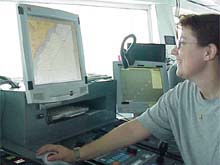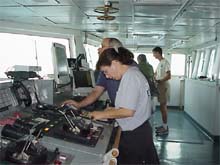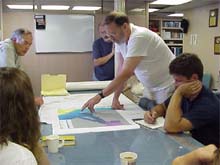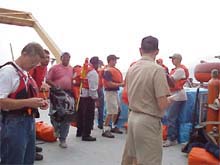
Navigational Officer Jenn Pralgo, at the navigational controls of the Ron Brown. Jenn’s duties aboard ship include making sure that the ship steers in a proper and safe direction as we sail towards our first mapping and sampling station on the Hudson Canyon. To assist in her duties, she uses a GPS navigational system as pictured in her computer screen.
We are the Ronald H. Brown– Jenn Pralgo: Navigation Officer
August 29, 2002
Lisa M. Weiss, Watershed Coordinator
Jacques Cousteau National Estuarine Research Reserve
“Being a woman hasn’t been a big deal…I have been surprised, even embarrassed, by the number of people who are genuinely amazed that a woman might be capable of running a fishing boat. Frankly, I’m amazed that they’re amazed...I might be thick-skinned-or just too busy working to worry about what others might think of me.”
Try to imagine being one of two cats, in a group of dogs. Would you feel outnumbered? Would it change the way you acted? Would you have to be tough, or would you act cowardly? Now try to imagine being one of two women working with a group of about 25 men, out at sea for legs of 20 to 40 days at a time. Sounds tough, doesn’t it? This is the type of scenario that Jenn Praglo, navigational officer aboard the Ron Brown, faces in her job and in her daily life.

Jenn working with Larry to ensure that the Ron Brown has the most updated navigational software possible. These computers and ship’s control are found in the “bridge,” which is where the ship is steered, as well as where watch is held. It has a 360-degree view around the ship so that any potential hazards to navigation can be detected. Click image for larger view.
As a child, Jenn was a member of the civilian air patrol, which helped to promote everyday citizens' interests in national protection actions. She attended NY Maritime Academy as an undergraduate, where she majored in meteorology, oceanography and environmental sciences, in addition to receiving her 3rd mate's license. Jenn's career at sea started when she worked on large yachts for two years, after which she began working for NOAA onboard the Ron Brown. She has been an officer aboard ship for almost a year and a half now.
Being the navigational officer means that Jenn plans the ship's course from our departure from Miami, up to our research site at the Hudson Canyon, the track that we are going to follow for the seafloor mapping and water-sample collecting, and then our trip into port in New York City. Jenn chooses a set of "way points", which are specific areas on the navigational chart, all along our route, to which the ship has to steer to remain "on course". She is assisted in her duties by two computers and a paper chart, all on which she plots the ship's trackline, sets the way points, and avoids anything in our path that could be considered a hazard to navigation. Even in this age of technology and computers, the Coast Guard mandates a paper chart detailing the ship's course.

Marine geologist, Jim Robb pointing out track lines for deep-sea mapping of the Hudson Canyon. This meeting was held among the scientists, the ship’s officers and the technical crewmembers that will assist the scientists in making sure that their data is properly collected. Meetings such as these are important so that the scientists can communicate with the ship's crew and the proper navigational planning can begin. This ensures that the scientific mission of the ship will be a success. Click image for larger view.
The ability to plan ahead in Jenn's job becomes compromised when scientific research projects are a factor. A prime example of this developed at a science meeting held yesterday. The scientists discussed with the ship's officer and crew the track that they would like to follow during the seafloor mapping and the collection of the water column samples. For the Hudson Canyon mapping to be done thoroughly, we will be mapping an area of the canyon that is 60 miles wide, by 100 miles long, back and forth (like a person mowing their lawn). The number of tracks that will be run, along with the distances of separation between the tracks, and the point of turning for the ship all have to be entered into the ship's navigational computer before we approach the site.
Throughout the mapping, CTD samples will be taken from the water column. To ensure that samples are collected vertically from one another up the water column, the ship will have to be held in the same position. It is Jenn's job to ensure that this is done properly. This technique is called dynamic positioning, and can be controlled by the ship's thrusters, once the exact global positioning system point for the sample collection site is entered into the computer system. One of the most challenging parts of Jenn's job is when last minute plans develop, tracklines get altered, and computer systems have to be adjusted.

Crew, officers, and scientific party during an abandon ship drill. The Coast Guard mandates these types of drills so that the crew and visitors are aware of their duties and procedures in case of an emergency situation. Each drill is treated as if it were the real thing, and appropriate gear must be worn in case an exit into the life rafts is necessary. Click image for larger view.
Jenn's other duty onboard the ship is to run the damage control drills. These include fire drills, man overboard drills and abandon ship drills. Because the ship is so far offshore, the Ron Brown must be self-sustained in its fire-fighting abilities. Members of the crew are certified as firemen, and it is up to them, in the case of an emergency, to be able to extinguish a fire. For this reason, the Coast Guard mandates that there be drills within 24 hours of leaving the port, and each drill is treated as if it is the real thing. The same holds true for the abandon ship drills, where all members aboard the ship have to muster in their designated lifeboat stations, as if we were ready to leave the ship.
Jenn says that one of the most challenging parts of her job is that she is one of the few women aboard and she doesn't have the opportunity to call up her girl friends and chat. She says that aboard ship it is a "man's world", but she has become thick-skinned and enjoys every minute of it. It hardly fazes her anymore. She does get lonely for her family and friends on shore, but then again, who wouldn't? Jenn gets her greatest sense of reward when the scientists that are aboard ship get their job done and they are able to collect quality data.
Sign up for the Ocean Explorer E-mail Update List.























